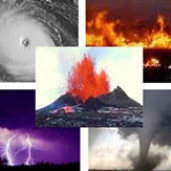
Officials typically encourage people to stay off the roads as much as possible during major winter storms (especially when there is a freezing mix of ice, sleet and/or snow), but if you must travel, be prepared in case something goes wrong.
Driving - If you must travel, consider public transportation. Best to travel during the day, don’t travel alone, and tell someone where you’re going. Stay on main roads and avoid taking back roads.
Winterize car – Make sure you have plenty of antifreeze and snow tires (or chains or cables). Keep gas tank as full as possible during cold weather.
Winter Kit – Carry a “winter” car kit in trunk and throw in…
- warm things – mittens, hat, emergency blanket, sweater, waterproof jacket or coat
- cold weather items – windshield scraper, road salt, sand
- emergency items – bright colored cloth or distress flag, booster cables, emergency flares, tow chain, rope, shovel
- miscellaneous – food, water, radio, etc.
Stranded- If you get trapped in your car by a blizzard or break down…
- get off the road – if you can, drive car onto the shoulder
- give a sign – turn on hazard lights and tie a bright cloth or distress flag on antenna, door handle or hang out the driver side window (keep cloth/flag above snow so it draws attention)
- stay in car – stay inside until help arrives (your Car Kit can provide food, water and comforts if you planned ahead)
- start your car – turn on car’s engine and heater about 10 minutes each hour (open window slightly for ventilation so you don’t get carbon monoxide poisoning)
- light at night – turn on inside light so crews or rescuers can see you
- if you walk – if you walk away from car, make sure you can see the building or shelter (no more than 100 yards/10 m)
- exercise – DO NOT overdo it, but light exercises can help keep you warm
- sleeping – if others are in car, take turns sleeping so someone can watch for rescue crews
- exhaust pipe – check exhaust pipe now and then and clear out any snow buildup
Watch for signs – playing, working or getting stranded out in the snow can cause exposure so look for signs of…
- frostbite – loss of feeling in your fingers, toes, nose or ear lobes or they turn really pale
- hypothermia – start shivering a lot, slow speech, stumbling, or feel very tired
Above extracted from our IT'S A DISASTER! book. Download a free ebook with more preparedness tips at www.usfra.org/fedhealth
And feel free to share your driving tips or stories below for others.



